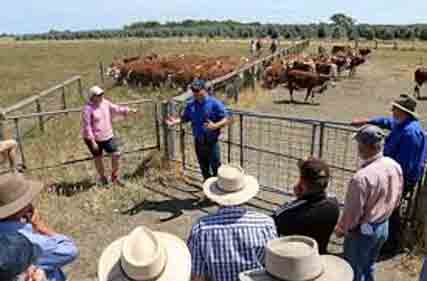
It is the fourth in a series of weaning acclimation workshops spanning South Australia, Victoria and NSW, with more planned for this year.
Practical advice on pressure and release cattle handling techniques during yard weaning were lapped up by beef producers at a Herefords Australia weaning acclimation field day.
The field day was hosted by Winderadeen Corporation’s Eringoarrah Station at Wantabadgery, in southern NSW, on March 11.
It is the fourth in a series of weaning acclimation workshops spanning South Australia, Victoria and NSW, with more planned for this year.
Beef producers attended from Cootamundra, Bowna, Adelong, Walla Walla, Collector, Holbrook, Junee, Jugiong and Narrandera.
The event was supported by Herefords Australia, Meat & Livestock Australia and Coopers Animal Health.
Guest speaker was feedlot consultant Dr Kevin Sullivan, Bell Veterinary Services, Queensland.
Dr Sullivan demonstrated low stress cattle handling skills for confined areas and outlined the correct way to train and yard wean cattle to prepare them for feedlot entry, if required.
He told the producers the techniques were not a step-by-step guide but an understanding or philosophy of communicating with cattle.
It was about instilling confidence in the cattle so they have no anxiety about people, vehicles, horses, or motorbikes.
“This is a whole-of-life training – we don’t want to desensitise animals so they won’t move, we want them to respond when asked,’’ Dr Sullivan said.
“Cattle see things in two dimension and have a deficit of depth perception so always stand in a position where they can see you.
“Each time a cow walks past a person without pressure, it’s confidence will build.’’
Dr Sullivan said their natural behaviour could be used to position cattle.
“A cow standing side on and looking at the handler is confident and wants to work with the human,’’ he said.
“If the cow is standing straight on, she is in a position to fight or run away.’’
Dr Sullivan described the eye as the “powerhouse’’ of the animal.
“Look around the eye and direct your motions towards the eye – cattle can be put up a race simply be putting pressure on the eye so it is a powerful tool,’’ he said.
Eringoarrah Station manager Cam Anderson weans around 1500-2000 Hereford calves a year, with the progeny grown out to feedlot entry weights.
Mr Anderson said soft handling techniques were already in use but the concept of yard weaning would be explored for Eringoarrah.
The calves are paddock weaned and fed a ration for 10 days, and educated to motorbikes and horse riders during that time.
They are vaccinated with a 7-in-1, receive a backline drench and pink eye treatment in required.
Mr Anderson was keen to know more about vaccinating weaners with the Coopers Bovilis MH + IBR to prevent respiratory infections.
“It could be a great on-farm tool to use,’’ he said.
Terry Goldsworthy and daughter Lauren, of Wantabadgery, planned to implement their new techniques learnt at the field day a few days later at weaning.
They finish their Hereford steers to export weights on their mixed farm, with the calves simply vaccinated and trucked 5km away from their mothers.
Mr Goldsworthy said he picked up tips on socialising the calves with daily human contact and working them through the yards and crush.
“We will consider yard weaning but the drawback is our yards are small without troughs,’’ he said.
Lauren was keen to implement the pressure and release techniques to keep the cattle quiet.
“I am a small person so it will make me feel a bit safer in the yards,’’ she said.
Former beef extension officer and now animal science lecturer at Charles Sturt University, Michael Campbell, was a keen participant.
He runs Black Baldy females joined to Limousin bulls with the progeny turned off at feedlot weights of 450kg live.
“We can always learn new ways to approach cattle,’’ Mr Campbell said.
“This method is a lot more enjoyable than a lot of yahooing. The main tip I picked up was working the cattle from the front as we all fall into the habit of pushing from behind.
“It is a matter of continually practising low stress stock handling .’’
Mr Campbell yard weaned early his 5-6 month old calves over 10 days, feeding pellets on conveyor belting, to accommodate a change in calving times.
Not all participants were whiteface breeders with prominent commercial Angus producer Ian Seidel, of Narrandera, attending to learn new tips.
He traditionally turns off 400 calves into the January Wodonga sales from his autumn calving herd.
“I yard wean at 9-10 months, feeding round bales of hay ad lib in hay rings and supply clean water,’’ Mr Seidel said.
“After four days, the calves stop bellowing and I take out the replacement heifers, then run the cull heifers and steers as one mob.’’
After attending the field day, Mr Seidel plans to introduce quieter cattle handling methods and vaccinate with Bovilis MH + IBR.
Winner of the Coopers Animal Health vaccine fridge on the day was Simon Ward, of Holbrook.
